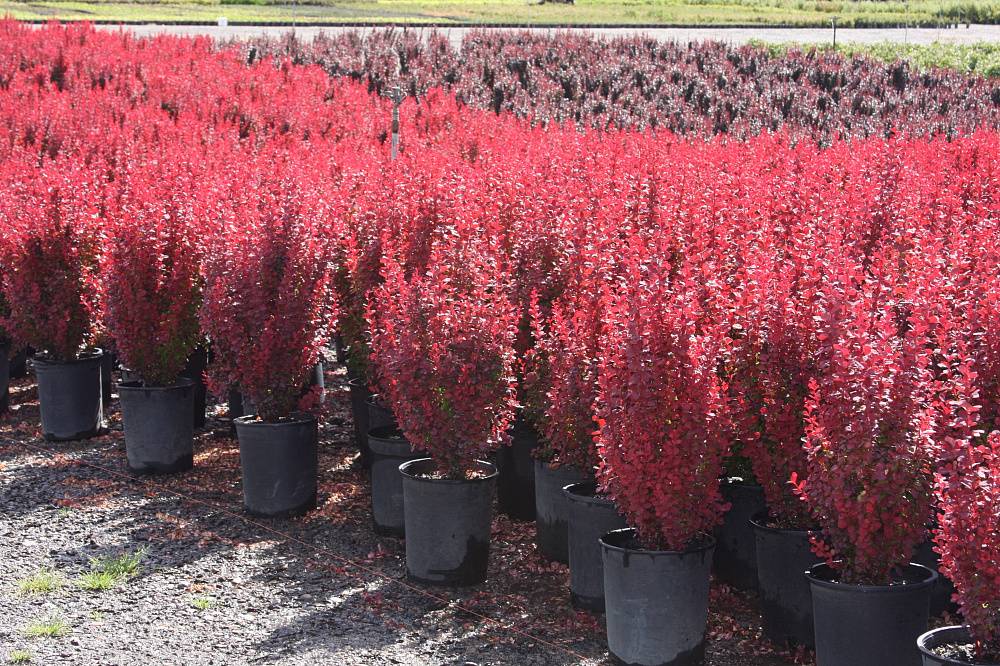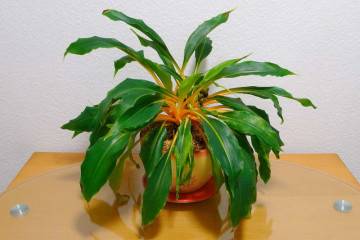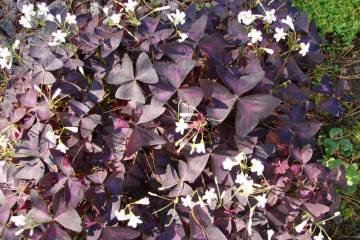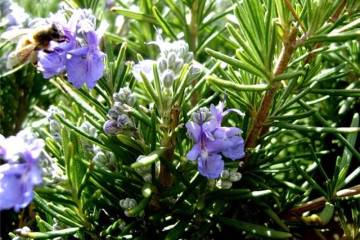Barberry Orange Rocket - description and cultivation
Content:
Gardeners arrange a summer cottage to their taste. Sometimes, as an example, they take neighboring plots as a basis. The owner's task is to have beautiful flower beds throughout the warm season. Therefore, flower beds are made up of completely different plants. In this regard, it is very profitable to plant ornamental barberry bushes of the Orange Rocket variety. These representatives of the mountain peaks of China and Japan have taken their rightful place in the gardens almost everywhere.
Description of the variety
Barberry (Berberis) is a deciduous plant. The shrubs are columnar. Branches directed upwards with sharp thorns. Leaves are oval, small, smooth. The size of the leaf plate is a maximum of 3 cm. The foliage is dense. It changes color from green in spring to burgundy by December. At the same time, the yellow edging of the leaf remains throughout the entire growing season.
In late May - early June, the bush is covered with yellow, tiny flowers, collected in small inflorescences. After 2.5-3 months, small red fruits ripen. They are not used for food.
The culture is unpretentious. It tolerates cold and drought well. In Central Russia, there is no need for winter shelter.
The maximum decorative effect of the bush is achieved only in a sunny area.
Barberry Thunberg Orange Rocket has a very powerful root system with a large number of lateral roots, it multiplies easily.
Of the positive properties, flower growers also list:
- disease and pest resistance;
- versatility in use;
- painless tolerance of pruning.
Growing barberry Orange Rocket from seeds
Barberry seeds are seeds. Seed harvesting begins with the collection of ripe berries. Full bones are treated with a manganese solution and dried naturally.
Sowing
In the second half of September, ready-made seeds are sown in a special bed. The depth of the hole is 1 cm, the distance between the seedlings is 3-4 cm. Young shoots will grow there for 3-4 years. After this period, the bushes are transplanted to a permanent place.
Seedling care
Seedling care is normal. The soil should be moist, but not soggy. Weeds should not be allowed to overgrow the beds. After the appearance of 2-3 leaves, you can begin to apply organic fertilizers along the loosened aisles. The frequency of dressings is no more than twice a month. With the first frost, watering and fertilization stop. The garden bed is covered with straw, dry foliage, peat or spruce branches. With the arrival of spring, the shelter is removed gradually.
Landing in open ground
A light dry area is selected for the plant. The close occurrence of groundwater (any accumulation of moisture) is detrimental to the root system of a culture. And it endures drought for a long time.
For planting, a hole is dug in accordance with the size of the root system of the seedling. A thick drainage layer is poured onto the bottom. It can be:
- expanded clay;
- small stones;
- crushed stone;
- crushed brick.
For good aeration and enrichment of the soil with nutrients, the excavated soil is mixed with humus and sand.
When to plant
Orange Rocket in open ground should be planted during the dormant period before the beginning of the growing season. If the seedling was purchased in the spring, it is better to leave it in a pot until autumn. After the end of the active growth phase, it can be planted in a permanent place.
How to plant
Experts recommend buying seedlings in containers. In this case, you do not have to worry about the integrity of the root system. Such a plant takes root well in a new place.
Before planting, the landing hole should be properly prepared. In advance, you need to prepare a nutritious soil (humus, sand). The young plant is pulled out of the container by the transfer method, placed in the hole. The roots are straightened along the bottom of the hole and covered with earth. Then the soil surface is slightly compacted and heavily spilled with settled water. To preserve moisture, the root zone is sprinkled with mulch. Peat or sawdust are perfect as the latter.
It will not be superfluous to add complex fertilizer to the soil. It can be purchased from a specialist store. The proportions and description of feeding are available in the instructions.
If the orange barberry is planted as a hedge, a trench is dug instead of a hole. The rest of the landing rules are similar to the ditching methods.
Plant care in the garden
In the care of the crop, only watering, feeding and pruning are required.
Water stagnation should not be allowed, but irrigation 1-2 times a week will allow you to get a lush, healthy plant. Watering should be combined with loosening and weeding of the root zone.
Watering is especially important at first. When new shoots appear, it can be reduced.
In the first year, it is possible to do without feeding. But starting from the second month after planting, it will be useful to feed the plantings with organic matter. Suitable:
- bird droppings solution;
- infusion of weeds;
- urea.
You can also apply complex feeding.
For the growing season, 1-2 procedures are enough.
In early spring, sodium supplements are useful, in summer - phosphorus-containing, and before winter - potash. Once every four years, it is recommended to feed the bush with a solution of urea (nitrogen compound).
Autumn feeding is especially important. With it, the plant will more easily endure wintering.
As for sanitary pruning, it is carried out before the start of sap flow, that is, in early spring. All damaged, dry, weak shoots are cut out. Then you can thin out the thickened crown. If it is a hedge, trimming gives the desired shape to the plantings.
Over time, a rejuvenating procedure is required. In this case, the Orange Rocket barberry is cut under the stump.
How to water a plant
In wet weather, there is no need for watering. In dry weather, adult plants are watered 2 times a week, and newly planted ones every other day. Water for irrigation should be warm. Watering itself is carried out only at the root.
Loosening the soil around the root will increase aeration.
Reproduction
Reproduction of the Thunberg barberry Orange Rocket does not seem to be a difficult procedure.
Culture multiplies:
- layering. The most used option;
- cuttings. Gives the highest survival rate;
- dividing the bush.All varietal qualities are preserved;
- seeds. A complex method, rarely used. Varietal qualities are not preserved.
Diseases and pests
With its high immunity, the Orange Rocket barberry can be attacked by pests. We are talking about insects such as:
- barberry sawfly;
- moth;
- aphid.
A 30% solution of laundry soap will help to get rid of them.
Sometimes the culture is affected by diseases such as:
- leaf spot;
- rust;
- withering;
- powdery mildew;
- bacteriosis.
The affected parts of the plant must be collected and burned. To prevent further development of the disease, the bushes must be treated with chemicals (for example, chlorophos, decis).
Flowering period and care after
In late May - early June, a huge number of small flowers, collected in inflorescences, appear on the bush. The flowers are yellow with a bloom of red. They last for about three weeks. After pollination, ovaries form in their place.
During flowering, it is required to carefully monitor watering and apply phosphates (for example, nitroammophoska).
Preparation for wintering
In winter, only young annual shoots are at risk. For their safety, you can insulate with spruce branches, straw or cover with burlap. Mulching the near-trunk area, applying phosphate fertilizers also contribute to a good wintering of the bush.
Use in landscape design
To decorate the garden plot, Orange Rocket barberry is used in different variations. A hedge looks great only from this culture. They can be used for edging flower plantings, borders. He can act as the central figure of an alpine slide.
Unwanted neighbors for him:
- cherry;
- hazel;
- elder;
- acacia.
These crops have a very developed root system, which inhibits the roots of the barberry itself.
Barberry Thunberg (Thunbergii) Orange Rocket will adorn any summer cottage. Decorative foliage will delight the eye from early spring to late autumn. It can be used in any landscape design. The unpretentiousness of culture makes it desirable for every grower.



















